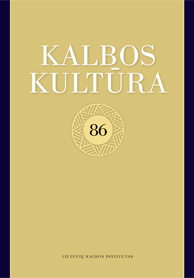EMOCINĖ-EKSPRESINĖ LEKSIKA LIETUVIŲ KALBOS NAUJAŽODŽIŲ DUOMENYNE – NAUJADARŲ RADIMOSI APLINKYBĖS IR DARYBOS BŪDAI
EMOTIVE-EXPRESSIVE LEXIS IN THE DATABASE OF LITHUANIAN NEOLOGISMS: FACTORS INFLUENCING ITS EMERGENCE AND TYPES OF WORD-BUILDING
Author(s): Agnė AleksaitėSubject(s): Theoretical Linguistics, Lexis, Baltic Languages, Stylistics
Published by: Lietuvių Kalbos Institutas
Keywords: emotive-expressive lexis; neologism; occasional derivatives; word-formation analysis; types of word-formation; productivity;
Summary/Abstract: The aim of the study is to identify the main types of word-building of the emotive-expressive neologisms and to examine the most productive means used in the coining of these new words. The object of the research includes 479 neologisms that perform emotive-expressive function. The word-formation analysis of emotive-expressive lexis included in “The Database of Lithuanian Neologisms” (DN) revealed that: 1. Stylistically connotated neologisms are formed mostly by means of suffixation (45.7 %), composition (31.7 %) and blending (12.7 %), the latter being a non-morphemic type of word-building. 2. The most formative suffixes of the most productive type of formation, i.e. suffixation, are as follows: the suffix -(i)ukas, -ė (6.8 %) in the formational category of names of possessors of nominal characteristics and the suffix -izmas (6.8 %) in the formational category of names of characteristics (nominal abstractions). 3. The data of DN show that the following elements of compounds valdžia- (first component), -skleisti (-skleidė) and -žmogis (second component) are productive elements of stylistically connotated neologisms. 4. Less productive types of word-building are prefixation (5.6 %), mixed type of word-formation (2.4 %) and inflectional derivation (1.9 %). 5. This was the primary research on emotive-expressive lexis, which revealed the necessity to stylistically edit some neologisms in DN. Moreover, seeking to conduct an in-depth analysis on tendencies in formation of emotive-expressive lexis, more diversified and numerous sources should be included. 6. The data available in the database should be analysed not only in terms of word-formation but also from the perspective of ethno-linguistics. Lexis is a reflection of the society and the neologisms (signs of realities of current time) stored in the database provide valuable information about a certain period in the life of nation.
Journal: Bendrinė kalba (iki 2014 metų – Kalbos kultūra)
- Issue Year: 2019
- Issue No: 92
- Page Range: 1-27
- Page Count: 27
- Language: Lithuanian

